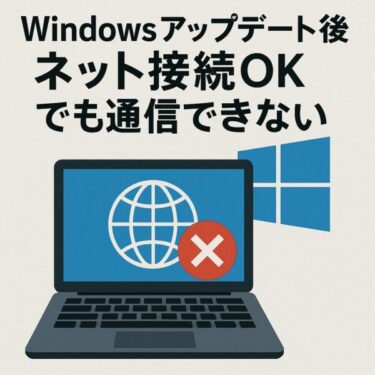
What to Do If You’re Connected to the Internet but Can’t Access the Web or Email After a Windows Update
After a recent Windows update, some users have reported a strange issue: their PC says it’s connected to the internet, but they can’t access any websites or download email. The Wi-Fi or Ethernet icon appears normal, but browsers return connection errors and apps like Outlook or Teams remain offline.
In this article, we’ll explain what causes this issue and how to fix it step by step. Even if you’re not a tech expert, don’t worry—these instructions are beginner-friendly and designed to help you restore normal network communication.
Common Symptoms
This issue can appear in several forms, including:
- The network icon shows “Connected” or “Internet access”
- Web browsers like Chrome or Edge show “Cannot connect” errors
- Email apps fail to send or receive messages
- Apps like Microsoft Teams, OneNote, or Skype remain stuck in offline mode
Important: Even though your device appears connected, communication with external servers may be blocked or misrouted internally. This typically points to DNS, firewall, or proxy misconfigurations.
Likely Causes After a Windows Update
1. DNS Server Issues
DNS servers translate website names into IP addresses. If this process fails, websites won’t load even if the internet is technically connected.
Tip: The June 2025 update (e.g., KB5060533) has been reported to interfere with DNS resolution in some cases.
2. Automatic Proxy Settings Changed
Some updates may unintentionally enable a proxy server in Windows settings, which can block or reroute traffic in a way that breaks normal access.
Note: This is especially common in enterprise networks or school-issued laptops.
3. Windows Defender Firewall Blocking Traffic
Firewall rules may be modified after an update, blocking apps or ports that were previously allowed.
4. Update Bug Affecting the Network Stack
Specific updates may introduce bugs that affect the Windows networking stack or drivers, especially in custom hardware setups or older PCs.
How to Fix It
1. Change DNS Settings to Google’s Public DNS
- Go to Control Panel > Network and Sharing Center
- Click on Change adapter settings
- Right-click your active network connection and choose Properties
- Select Internet Protocol Version 4 (TCP/IPv4) and click Properties
- Choose “Use the following DNS server addresses” and enter:
Preferred DNS:8.8.8.8
Alternate DNS:8.8.4.4
Why it works: Google’s DNS servers are fast and reliable, bypassing any issues with your ISP or Windows auto-configuration.
2. Disable Proxy Settings
- Go to Settings > Network & Internet > Proxy
- Turn off any “Use setup script” or “Manual proxy setup” options
3. How to Reset Windows Firewall to Its Default Settings
- Open Control Panel > Windows Defender Firewall
- Click Restore defaults on the left menu
- Click Restore defaults again and confirm
Note: This step can unblock services or ports that were mistakenly disabled by an update.
4. Uninstall Problematic Windows Update
- Go to Settings > Windows Update > Update history
- Select Uninstall updates
- Look for KB5060533 or any recent update and click Uninstall
Important: Restart your PC after uninstalling the update to apply changes.
Advanced Tricks and Workarounds
Use Command Prompt to Reset Network Stack
Open Command Prompt as Administrator and run the following commands:
ipconfig /flushdnsnetsh int ip resetnetsh winsock resetThese commands reset DNS cache, TCP/IP settings, and Winsock—often resolving hidden issues caused by updates.
Try Network Reset (Full Reset)
- Go to Settings > Network & Internet > Status
- Click Network reset at the bottom
- Click Reset now and reboot
Warning: This will remove saved Wi-Fi passwords and VPN settings. Use it as a last resort.
Boot into Safe Mode with Networking
To determine if third-party apps are causing the issue:
- Hold Shift while clicking Restart in the Start Menu
- Select Troubleshoot > Advanced options > Startup Settings
- Choose option 5: Enable Safe Mode with Networking
Temporarily Disable Security Software
Some antivirus programs may block traffic after updates. Try disabling them briefly to see if connectivity improves. If it does, consider switching to Windows Defender.
Switch to Wired Ethernet Connection
When in doubt, test with a physical Ethernet cable. If it works, your wireless adapter or drivers may be affected by the update.
Preventing Future Issues
- Create a System Restore Point before installing major updates
- Manually configure DNS and proxy settings so they don’t reset automatically
- Run the built-in Network Troubleshooter regularly from Settings > Network & Internet
These habits can help you detect problems early and avoid being caught off guard by hidden update side effects.
Tip: If you experience frequent issues, consider delaying updates by a few days to let early bugs be patched.
Conclusion
Windows updates are essential for security and performance—but sometimes they come with unexpected side effects. If your PC shows that it’s connected to the internet but refuses to load websites or apps, don’t panic. Follow the steps in this guide to regain control over your network settings and get back online.
We hope this article has been helpful in resolving your issue.
✔️You might also find these helpful:
▶︎How to Use Public Wi-Fi Safely Without a VPN (2025 Edition)
▶︎7 Safe Ways to Use USB Drives and External SSDs (A Must-Read for Remote Workers)
▶︎Why Is My Surface Battery Draining During Sleep? Real Causes and Fixes (2025 Edition)


![[2025 Guide] Install Windows 11 24H2 on Unsupported PCs (Bypass Compatibility Check)](https://kimiyoya.com/wp-content/uploads/2025/06/8BEB1D13-F504-4370-BB04-204C42714A8A-375x375.jpg)